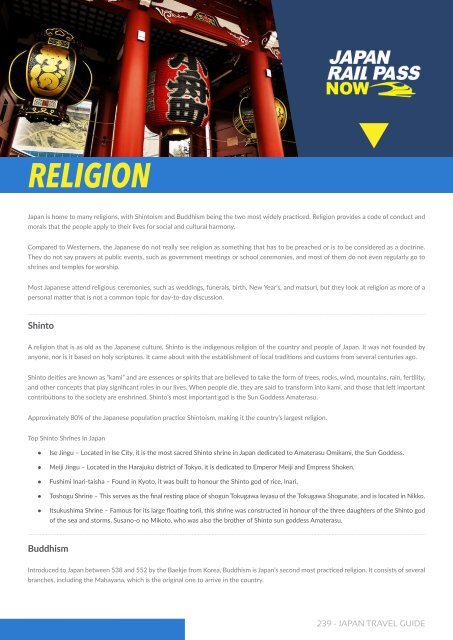Japan Rail Pass Now - Japan Travel Guide
Japan Travel Guide by Japan Rail Pass Now (www.japanrailpass.com.au)
Japan Travel Guide by Japan Rail Pass Now (www.japanrailpass.com.au)
You also want an ePaper? Increase the reach of your titles
YUMPU automatically turns print PDFs into web optimized ePapers that Google loves.
Religion<br />
<strong>Japan</strong> is home to many religions, with Shintoism and Buddhism being the two most widely practiced. Religion provides a code of conduct and<br />
morals that the people apply to their lives for social and cultural harmony.<br />
Compared to Westerners, the <strong>Japan</strong>ese do not really see religion as something that has to be preached or is to be considered as a doctrine.<br />
They do not say prayers at public events, such as government meetings or school ceremonies, and most of them do not even regularly go to<br />
shrines and temples for worship.<br />
Most <strong>Japan</strong>ese attend religious ceremonies, such as weddings, funerals, birth, New Year’s, and matsuri, but they look at religion as more of a<br />
personal matter that is not a common topic for day-to-day discussion.<br />
Shinto<br />
A religion that is as old as the <strong>Japan</strong>ese culture, Shinto is the indigenous religion of the country and people of <strong>Japan</strong>. It was not founded by<br />
anyone, nor is it based on holy scriptures. It came about with the establishment of local traditions and customs from several centuries ago.<br />
Shinto deities are known as “kami” and are essences or spirits that are believed to take the form of trees, rocks, wind, mountains, rain, fertility,<br />
and other concepts that play significant roles in our lives. When people die, they are said to transform into kami, and those that left important<br />
contributions to the society are enshrined. Shinto’s most important god is the Sun Goddess Amaterasu.<br />
Approximately 80% of the <strong>Japan</strong>ese population practice Shintoism, making it the country’s largest religion.<br />
Top Shinto Shrines In <strong>Japan</strong><br />
●<br />
●<br />
●<br />
●<br />
●<br />
Ise Jingu – Located in Ise City, it is the most sacred Shinto shrine in <strong>Japan</strong> dedicated to Amaterasu Omikami, the Sun Goddess.<br />
Meiji Jingu – Located in the Harajuku district of Tokyo, it is dedicated to Emperor Meiji and Empress Shoken.<br />
Fushimi Inari-taisha – Found in Kyoto, it was built to honour the Shinto god of rice, Inari.<br />
Toshogu Shrine – This serves as the final resting place of shogun Tokugawa Ieyasu of the Tokugawa Shogunate, and is located in Nikko.<br />
Itsukushima Shrine – Famous for its large floating torii, this shrine was constructed in honour of the three daughters of the Shinto god<br />
of the sea and storms, Susano-o no Mikoto, who was also the brother of Shinto sun goddess Amaterasu.<br />
Buddhism<br />
Introduced to <strong>Japan</strong> between 538 and 552 by the Baekje from Korea, Buddhism is <strong>Japan</strong>’s second most practiced religion. It consists of several<br />
branches, including the Mahayana, which is the original one to arrive in the country.<br />
239 - <strong>Japan</strong> <strong>Travel</strong> <strong>Guide</strong>



